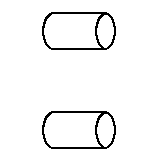Roman ring
A Roman ring, in theoretical physics, is a configuration of wormholes where for each individual wormhole the time difference across its mouths (caused by the mouths moving relative to each other) is such that it may not allow a closed timelike curve (CTC), or 'closed-time loop'. If these wormholes and their mouths are arranged in a suitable configuration, a closed time loop will be again possible.
For example, an Earth-Moon wormhole whose far end is 0.5 seconds in the "past" will not violate causality, since information sent to the far end via the wormhole and back through normal space will still arrive back on Earth (-0.5 + 1) = 0.5 seconds after it was transmitted; but an additional wormhole in the other direction will allow information to arrive back on Earth 1 second before it was transmitted (time travel).
Semiclassical approaches to incorporating quantum effects into general relativity seem to show that the chronology protection conjecture postulated by physicist Stephen Hawking fails to prevent the formation of such rings, although some experts such as Matt Visser feel that there are reasons to think the semiclassical approach is unreliable here, and that a full theory of quantum gravity will likely uphold chronology protection.



References
- Visser, Matt. "Traversable wormholes: the Roman ring". arXiv:gr-qc/9702043.
- Visser, Matt. "van Vleck determinants: traversable wormhole spacetimes". arXiv:gr-qc/9311026.
